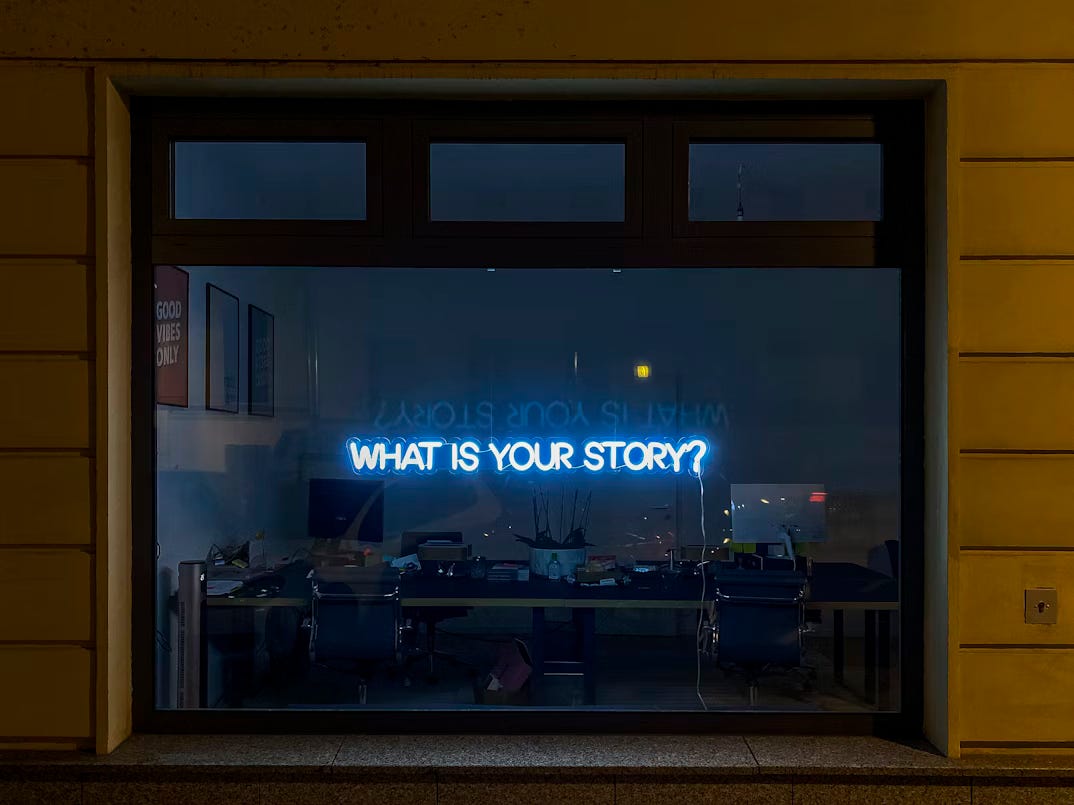The Story With No Ending is a Story No One Wants to Hear
Storytelling is vital for helping to communicate your mission as an OPO, and research suggests making sure people hear the ending is as important as the process itself.
KEY TAKEAWAY: RPG’s research shows that when donation-side hospital partners and donor families don’t hear the end of a donation story, they tend to feel marginalized, ignored and even forgotten… and less positive about the donation experience they just went through.
OPO Insights is a free weekly newsletter by Sean J. Jordan from RPG.
I write fiction in my free time, and I occasionally get asked to speak to people about the process of creating a story.
“The most important part of telling a story is that it has a clear beginning, middle and end,” I’ll tell them. “But the secret to telling a good story is that they’re all clearly connected. The beginning tells us where we’re going, the end tells us that we’ve arrived, and the middle tells us about everything in between.”
When I work with kids, they then go on to write wildly creative stories about their pets or friends or teachers or maybe favorite characters, but they get lost in trying to explain the meaning of it all.
When I work with teenagers, they have a strong tendency to think about the emotion of the story first rather than to establish the reason things are happening.
When I work with adults, they often want to tell stories that have a strong purpose behind them, but which are often mired in too much detail.
As an experienced writer, I am always careful with my feedback, because my belief is that any story can be a good one if enough time is spent in crafting it. It’s easy to tell a beginning writer that their ideas are trite and their craft isn’t up to standard. It’s much more rewarding, however, to spend time with them on the parts of the story that matter - the hook, the plotting, the characters, the theme, the flourishes and so forth - than it is to tear them down for creating something that isn’t perfect on the first try.
I bring all of this up because Organ Procurement Organizations have an absolutely incredible story to tell, and OPO personnel get to experience it over and over during their daily work in working on behalf of donors, interacting with donor families and facilitating transplantation for recipients. Every donation case has that most crucial element of storytelling - a beginning, a middle and an end, all connected by a life-saving mission.
When that story is told completely, it can change hearts and minds and create donation champions in the hospitals and communities.
But when it’s not? Research shows that the hospital partners and donor families involved have a predictable reaction:
They’re annoyed and upset that the story wasn’t told the right way.

The Proper Way to Tell a Story
I’m going to tell you an entirely fictional story about an 18-year-old girl named Joanna. We open on her living in Lincoln, Nebraska, where she works as a barista in a coffee shop. Joanna is frustrated because she feels like she’s stuck in a rut after graduation. She can’t afford college and she’s living at home with her parents who still treat her like she’s in high school. She desperately wants to be an actress, and she’s good at it, but she lacks the connections and resources needed to get herself to New York City or Los Angeles. Even so, she’s trying to save up so she can get out of Nebraska; every day, she drops her tips in a coffee can she keeps hidden in her closet, and on that can is a piece of duct tape with the words “Moving fund” written on it.
But then one day, Joanna meets a strange, shifty woman who asks if she can hire her to be the private barista at a party going on downtown. Joanna needs the money and accepts, but once she arrives, she realizes the gathering is for a bunch of organized criminals from the East and West coasts who have just joined their operations together and are planning to use Lincoln as their base of operations. Joanna decides she’s just going to put her head down and get through it, but then she serves coffee to a guy who’s trying to act like he’s a criminal, but he’s very clearly a young, inexperienced undercover federal agent.
Her acting instincts kick in and she tries to give him some advice about how to blend in. He tells her he’s from the New York office and the criminals have put their own people in charge of his agency, meaning he’s got to have a solid case to bring them down. He convinces her to be his ally so he can gather solid evidence of their wrongdoing and her job is to help him blend in. He promises, in turn, to help her get to New York, where he’ll introduce her to his cousin on Broadway.
After a series of misadventures, the agent gets caught and Joanna has to disguise herself as a criminal and set him free, putting her acting skills to the test as she interacts with the meanest, nastiest people she’ll ever meet as she pretends to be one of them. Her growing courage and confidence allow her to save the day, and after a moment of self-doubt and nearly getting caught, she overcomes it and manages to not just free the agent, but gather the intel he needs to ensure these criminals are brought down for good.
But Joanna’s story concludes not with her going to New York to become an actor, but instead becoming a contractor to the now less-corrupt federal agency for future undercover operations. And she enrolls in college in Lincoln, where she knows she’ll be safe, to work towards a degree in law enforcement in the meantime.
If this story sounds like it could be a Hollywood movie, it’s because it follows the common three-act structure adventure films often utilize. In Act I, the hero or heroine is stuck in a rut and needs something exciting called an “inciting incident” to break them free of it. In Act II, the result of that incident builds towards a dramatic climax, often with a moment of self-doubt or a feeling that all is lost. In Act III, the hero or heroine triumphs and resolves the conflict, but also walks away changed by the experience, perhaps learning something about themselves or having a new perspective on their situation.
You’ve definitely heard this story before, because it’s the story of Luke Skywalker in Star Wars or Neo in The Matrix or Marty McFly in Back to the Future or Woody in Toy Story or the Avengers or Frodo Baggins or Indiana Jones or Spider-Man or Harry Potter. It’s even the story of many classical heroes from ancient cultures around the world, so much so that the writer Joseph Campbell refers to this pattern as the “Hero’s Journey.”
Many other books have been written about this storytelling structure as well. One particularly famous book, Blake Snyder’s Save The Cat! The Last Book on Screenwriting You'll Ever Need, even goes so far as to proscribe on which page of a movie script things ought to be happening. Snyder even says that for the audience to fully connect to the hero or heroine, they need to see them do something explicitly good - such as saving a cat - so they know who to root for. (And when you know to watch for that “save the cat” moment, by the way, you’ll start seeing it in just about every movie made over the last two decades!)
So, why does the three act Hero’s Journey structure work so well? It’s because it provides the same three things I talked about earlier: the need for a beginning, middle and end that are not just a bunch of things that happen in sequence, but rather which are connected to a broader arc that helps to audience to understand where they currently are in a story, where it’s going and how to know when the story is wrapping up.
As it happens, the story of organ donation can be adapted to this structure as well. You just need to understand how to apply it.

The Proper Way(s) to Tell a Donation Story
Let’s return to our fictional character Joanna and say that sometime in our original story, we see on her driver’s license that she’s a registered organ donor. Following the advice of Save the Cat!, this helps us connect to her as a heroine because we know she’s a selfless person who gives to others.
But let’s say that in the inevitable sequel, Joanna is in a car chase and she has a motor vehicle accident that results in head force trauma. We cut to the hospital, where her prognosis is grim. She’s declared brain dead, but because she’s such a selfless person, her organs are able to be recovered and we’re told through this act, transplant surgeons were able save the lives of four other people. That’s the end of Joanna’s story.
But it’s also not a very satisfying one.
You see, we already knew Joanna was a good person, but what we haven’t been told about is any of the tension that might make that story interesting. Perhaps Joanna signed up to be an organ donor without telling her parents and they are shell-shocked as they sit at her bedside, questioning her decision before coming around to see her point of view. We might even show the discussions they have with doctors and nurses and Family Services and loved ones who are conflicted about the decision. That’s a more interesting story! There’s drama. There’s character development. There’s a lens through which we can examine Joanna’s motivations and how her life - and death - impacted others. Her legacy isn’t just to save the lives of four faceless people, but to impact those who were closest to her as well.
Act I is Joanna’s car chase and accident. Act II is the family discussing her decision to be a donor and hoping she’ll pull through but gradually accepting that she won’t. And Act III is the result of that decision, perhaps showing an Honor Walk and wrapping up with a memorial service where Joanna is remembered for how she inspired others.
That’s interesting! But it’s not the only story we can tell with this scenario.
Another could instead focus on the hospital staff and the organ procurement team having to work together to preserve Joanna’s wishes to be a donor while the hospital is flooded with patients due to the pile-up from the car crash Joanna’s adventure caused. We could watch the hospital staff strive to save as many lives as possible and to have to juggle this organ donation case amidst their busy evening. They could argue about whether or not Joanna will recover, and we could explore the lens of donation through their eyes. Or we might have a natural disaster - a power outage, a fire, an earthquake or something similar - impact the hospital’s ability to care for patients. The question of “will donation happen amidst all this chaos?” would be gripping, and the philosophical perspectives of different characters in the story could give us insight into the process.
Act I in this story is the hospital swelling with patients and overwhelming the clinical staff. Act II is the race to try to save as many as possible… and deal with this pesky organ donor situation that’s taking up time and attention. And Act III is the organ donation making it through the chaos, saving lives and causing a good thing to happen on a very, very bad day, fulfilling the wishes of the donor and her family and making the whole unit proud of what they accomplished.
But there are still other ways to tell this story!
We could explore the journeys of the four recipients after transplantation and see how Joanna’s selfless act impacted their lives
We could explore the impact of Joanna’s death on her family and watch them grapple with the emotion of losing a loved one and desperately searching for meaning and context as they begin to process their grief and loss, culminating in their meeting a recipient
We could have an adversary in the hospital administration who decides to be a barrier to her being a donor and watch the OPO, donor family and hospital staff form a coalition to fight this decision, ultimately triumphing over the objections and fulfilling her wish to be a donor
While the circumstances behind Joanna’s story are fictional, what I hope you’re noticing is that all of these structures apply to many donation cases and could be used to tell the story of a donor powerfully and memorably to someone else. There’s so much going on - life and death, grief and loss, bustling activity, the aspiration to save unseen lives, the drama of the hospital environment, the opportunity to celebrate the donor and the family for their heroism, and the renewal of life and hope for both the recipients and the loved ones touched by the case.
These stories are exciting! They’re meaningful. They’re interesting and philosophical and focus on the depths of what it truly means to sacrifice something for the greater good.
But as many right ways as there are to tell them, there are also some wrong ways. And sadly, our research shows many OPO staff don’t know how to tell these stories correctly.

Where the Donation Story Goes Wrong
One of the best pieces of advice I was ever offered during my brief stint as a journalist was that people love to see their names in print. It’s so true! One of my superpowers as a journalist was asking people to comment on things and assuring them I’d use their quote in my piece. Those folks were always my guaranteed readers, and I’d sometimes even receive a note of thanks for how well I portrayed them and captured the things they said.
The same principle holds true when you are telling a story that involves other people - they generally love to hear their names mentioned and how they contributed to the story you’re going to tell. But there are a few caveats to keep in mind:
They usually want the story to reflect well on them
They usually want the story to accurately capture their role within it
They almost always want the story to tie their participation to any positive outcomes
The first two points are challenging enough, but that third point is particularly difficult because it requires taking some time to think about what each individual contributed to the ending you want to get to!
Unfortunately, our research has shown pretty consistently that in following up on donation cases and donor family encounters alike, this third point is often the biggest point of contention and many hospital partners and donor families feel like they’re left out of the end of the story as the focus shifts from the donor to the transplantation.
It’s easy to understand why this happens - successful transplantation is the ultimate successful outcome of a donation case where an OPO is concerned, and the details have an important bearing on the OPO’s donation metrics.
But to those hospital partners and donor families, transplantation is an incidental detail in their story because they don’t see the organ transplant happening and rarely get to speak to the recipients. They’re happy to hear lives were saved, and they like to know details the same way that we might enjoy learning about what happened to Harry Potter after Voldemort was defeated once and for all.
But the key is that they first need to know that crucial third act of the story of the donor, and that means they need to know that things went well in the recovery process. And donor families, who still have a funeral to arrange and a grieving process to begin, also need to know that the recipients are benefiting thanks to their loved one’s sacrifice.
OPOs feel they do a good job of sharing this information. But in study after study, we hear that this information eludes many people - about half of all organ donor families and two thirds to three quarters of hospital partners. Even more important is understanding that when this crucial third act is shared, these partners and families tend to feel better about the process overall and express feeling aligned and valued.
But when this information doesn’t reach them? They feel marginalized, forgotten and unappreciated, and often worse about the experience overall.
That’s no good, and it means that OPOs need to take seriously that they’re not being very good storytellers about their own process and helping the people who are going through it to consistently understand the incredible things that are happening. And when an OPO is dealing with a tough case that makes the national news, some of those individuals who have already had some concerns about the story they were only partially told begin to suspect that maybe the OPO didn’t tell them everything because there was something the OPO didn’t want them to know.
But how do you fix this problem? Fortunately, the answer is something storytellers have honed over thousands of years: you match your story to your audience and then you make sure you tell them the beginning, middle and end.
It’s not as hard as it sounds. But it’s also not as easy as it looks.

The Best Way to Tell the Donation Story
Charles Schultz, the creator of the Peanuts comics, was a master storyteller. In just four panels, he could tell wildly different stories about his characters. The debut Peanuts strip from October 2nd, 1950 shows a smiling, bald-headed boy walking down the street and two kids sitting on the sidewalk talking about him. “Well! Here comes Ol’ Charlie Brown,” one kid says to the other. “Good Ol’ Charlie Brown… yes sir!” And as the smiling boy disappears from the frame, the kid continues into the third panel, as if he’s afraid of being overhead, “Good Ol’ Charlie Brown…”
And then, in the fourth panel, with a now-disgusted face, the kid finishes, “How I hate him!”
75 years have gone by and it’s still a masterclass in how to tell a story. We’re left with so many questions about a character we know nothing about - Charlie Brown wasn’t yet the star of the strip - and why these other two children are being so nice to him when he’s within earshot and so nasty when he’s not. We empathize with “Good Ol’ Charlie Brown” because he seems to be an undeserving target of this vile hatred, and yet we also are inclined sympathize with the kids on the sidewalk too because they’re the main characters in the brief story we’re being told… that is, until we discover at the end that maybe they don’t deserve our sympathy after all!
If a simple comic strip can accomplish so much in four panels, that’s a good indication that a story doesn’t need to be long or complicated to be impactful. In fact, you can tell quite a powerful story with just a few words.
Assuming, that is, that you choose them carefully.
“I just wanted to share that your MVA patient Joanna went to the OR on Tuesday and we successfully recovered and transplanted her heart, liver and kidneys,” you might say to a hospital partner. “We were able to save four lives in all. Thank you for your role in the case.”
This might sound like a good story to tell. It’s short. It’s detailed. It’s focused on the outcome of a donation case and it even has the words “thank you” in it!
But it’s also the wrong story for your audience because it presumes that they are invested in the story of transplantation. To some partners, that may be true. But to many others, this is background noise because it fails to tell them how they connect to the story.
So, let’s reword that story.
“I wanted to stop by and say thank you for your help in the case you were involved in the other day with your patient, Joanna, who came in through an MVA,” you might say. “It was a very challenging case. But because of the great work you did in helping us to manage her as a patient, the OR went very smoothly and we were able to recover her heart, two kidneys and a liver and fulfill her wishes to be a donor. Joanna would be happy - she managed to save four other people through that gift! You might also remember her parents from the Honor Walk - they are very sad, of course, but they’re doing well and are very proud of their daughter’s decision to donate, and we’ve already reached out to help them transition now that they’re back home. We would not have been successful in caring for this donor and her family without your help, and we’re very grateful to you. I’d be happy to answer any specific questions you have.”
It’s four times as long, sure, but let’s pay attention to some of the added details, because they’re important. First of all, we begin with the thank you because it sets up that the conclusion of this story is going to be an expression of gratitude. In storytelling, we call that a framing device, and it’s very effective here because it allows us to then share the details in the context of that frame.
Next, we go through the details that would be important to someone on the donation side of the story. They’re told in sequence, but they are also focused on Joanna and her family and how the gift of donated organs benefits them - Joanna by fulfilling her final wishes and her family through the lasting legacy she left behind and the outreach and services provided.
We close by returning to our framing device and explaining why this was so important to share with this partner. And then the end of the story is left open-ended to elicit further discussion.
This same framework could be utilized with a donor family who is inquiring about the outcome of a case.
“First of all, we just want to say thank you for everything you did to support your daughter and her heroic decision to be a donor,” you could begin. “We know this was an unexpected and very difficult situation for you, but it’s because of the great medical team and your family that Joanna’s wish to help others was fulfilled. We don’t have all the information available yet, but we know that the surgical team was able to recover her heart, kidneys and liver and that four different recipients benefited from her gift. I know you’d like to talk to them, and we have a process for doing that to make sure that everyone’s privacy and boundaries are respected. We can talk about that in a moment. But let me bring things back to Joanna for a moment. If it were not for her decision to be a donor, these four people would probably not be here today. She was an absolute hero to them, and we are so honored to be able to provide any care and support needed for you now because we know that’s what she would have wanted. We are so grateful to her and to you.”
This structure might not be exactly suited to how your OPO communicates with donor families, but it does provide three things that could be very useful for them. First, it uses the same framing device of gratitude to convey the important information in between the kind words of thanks. Second, it acknowledges the information the donor family wants to know - what was recovered and how others benefited from it - while still setting expectations about what information can be provided. Finally, it brings things back to the donor and her impact on these other people through her heroic act.
When the stories of donors are being relayed this way, hospital partners and donor families take notice. These are the stories they want to hear - the stories that regard the role they played in fulfilling the donor’s incredibly selfless life-saving final wish. They don’t want to be the hero. They just want to be acknowledged for helping things along, and they’d like to know what happened once their involvement ceased and the OPO and the transplant surgeons got involved.
And it really only takes a few carefully-worded sentences to tell them all of that.

Making Storytelling Part of Your OPO’s Culture
My advice may make storytelling sound easy, but I assure you that taking time to learn to tell stories properly is not something that you can just start doing. So much of storytelling comes from having the courage to get in front of an audience and gauge their response. One of the most important pieces of feedback that audience can provide is whether or not your story is understandable. Another is whether or not it’s interesting enough to be engaging. And yet another is whether it’s memorable enough to cut through the noise of their daily life and stick with them.
Many stories are too detailed or too vague to fulfill all three of those criteria, and it’s easy to make them feel too cold and clinical for some audiences and too light and fluffy for others. And then there’s the whole issue of how those stories are being told - your tone, your speed, your body language and your personal style can all make a big difference in how well a story lands. So, too, can the willingness of your audience to listen.
What I would recommend to any OPO is to hold a series of storytelling workshops with a practiced storyteller that allow front-line staff to experiment with frameworks and ideas for sharing stories with key partners. One important skill for storytellers to develop is learning to have empathy for the audience and to understand how the words they use might be perceived in the absence of direct experience. For example, an audience might feel patronized if they’re simply being lectured about taking their time and doing things right, but if you can engage them with an imaginative story about a race between a tortoise and a 17-year cicada, they may well listen to see where things are going.
Stories do not always need to be communicated through speech, either! Learning to tell effective stories through emails, text messages, infographics, illustrations, photographs, slide decks or videos can be just as impactful. Sharing these stories internally and working to develop them into multiple formats can also help to improve their effectiveness and efficacy.
I’ll also note that many OPOs already have some storytelling baked in to their culture. Many OPOs encourage their staff or donation champions to be a part of “connect to purpose” stories and many also have a format for telling “the OPO story” at the beginning of a presentation. After cases, many OPOs also use case reviews to discuss the clinical aspects and outcomes of donation cases. These are all good frameworks, but they each also have a big weakness - they’re designed to tell the audience why the OPO’s mission matters. They’re not well-suited to talking to those involved in cases about their own role.
Remember what I said before - the real story that needs to be told is how those who touched a case supported the donor. That’s the story hospital partners and donor families truly want to hear.

One Last Story to Wrap Things Up
I’m sure I’m not surprising anyone by saying it’s been a rough year. I have known many people who have lost their jobs this year, and I suspect I’ll know even more in the months to come. I also know many folks in the OPO world are feeling the pressure of the national discussions occurring and the weight of the CMS metrics from the Final Rule. We are facing a lot of uncertainty, and all we can really do is hold on and help each other.
If you are struggling in any way, please know that we at RPG are here for you. You can reach out to me any time via email, Zoom or phone. My calendar is here: https://calendly.com/sjordan-rpg.
And you are always welcome to join us for our free monthly Best Practices Summit Virtual sessions!
Sign up here: https://www.researchplan.com/bps2025
Videos can be found here: https://www.researchplan.com/bpsvideos
I’m of course also happy to help your organization with research projects, public speaking needs or training. I’m happy to talk about storytelling, customer experience, marketing strategy, healthcare our vast experience in research or anything else I can provide. Just ask and I’ll be there!
I also encourage you to reach out to your colleagues and check in on them. Everyone can use a kind word now and then, and one lesson I’ve learned this year is that they are in short supply but have an incredible impact.
Let me close with this story, because I want to remind you just valuable offering thoughtful help to others can be.
I’ve been reading up on customer service lately and I came across something in the Disney Institute’s handbook Be Our Guest: Perfecting the Art of Customer Service that reminded me how powerful storytelling really is. I’ve read many customer service books that talk about the the importance of putting your ego aside, having a service mentality, showing empathy to others and other things like that. None of this is revolutionary, but it’s all tremendously important for providing the best possible experience in a service encounter.
The Disney Institute has a different, more intuitive way of explaining all of this, however; they talk about how they train the staff (or “cast members”) in Disney theme parks to be ready for simple question:
“What time is the 3:00 parade?”
Allow yourself a moment to be stunned by the question, because it really is shocking that anyone would ask this. To me, it evokes an image of a family standing on a pathway in the park looking completely confused as they crowd around their smartphone trying to locate the information they need. The parents are overwhelmed and exhausted and snapping at each other while their kids are grumpy and bored and preparing to wander off. They spy a Disney cast member walking by, perhaps cleaning up litter along the walkway or heading to work at a concessions stand, and one of the parents blurts this question out in sheer desperation.
It seems like the sort of encounter that ought to happen pretty infrequently. And yet the Disney cast members need to be trained to answer it correctly because it turns out that this question is surprisingly common.
The least helpful approach is to answer the question directly. “3:00!” might seem like a perfectly acceptable answer if it’s said with a smile, but it also suggests to the park guest that the cast member is not actually trying to be helpful. An equally unhelpful approach is to make a joke about the way the question answers itself or to feign sarcasm or annoyance. All of these approaches result in the guest not being served properly and the cast member potentially looking like a jerk.
And so the Disney Institute trains staff to look at this question differently and to try to understand what is actually being asked. Obviously, the guest knows when the 3:00 parade is supposed to start, but what they don’t know is when it will come by the part of the park where they’re standing or where they might be able to get a great view of the costumed characters or whether they have a few minutes to grab some food or go to the restroom before it comes by. What they don’t want to do is miss out on the parade, and that’s really why they’re asking the question.
Understanding this, the cast members can then address that actual need. “The parade will be coming by in just a few minutes,” they can say, “and let me show you a great place to stand and watch it. Do you need anything before it starts? I can also show you where the restrooms are or where you can go and get some snacks.” And they can continue the conversation with the guest’s family about which characters they’re hoping to see, how their day has been going, and whether the guest has any other questions that need to be answered.
That’s a lot to take away from someone asking, “What time is the 3:00 parade?”! But the very notion of being asked something so ridiculous hardwires the cast members to be ready to provide the appropriate level of customer service.
What’s more, it gives them a skillset for providing that same level of service in any sort of situation where someone is confused or not asking a question clearly. All they need to do is smile and say to themselves, “I know how to deal with this. It’s the 3:00 parade question.”
And now you know how to deal with it too.
That’s the power of good storytelling.





